Modelling the Returnable Transport Items (RTI) Short-Term Planning Problem
Abstract
:1. Introduction
2. Literature Review
3. Problem Modelling and Proposed Approach
3.1. Modelling Assumptions
3.2. RTI Inventory Requirement and Fleet Size
3.3. RTI Short-Term Planning Approach
- Customer–Supplier Flow model: This first step is to define which customers return empty RTIs to which suppliers, with which quantity, and the optimal return frequency over each customer–supplier link. The optimal return frequency represents the minimum number of trucks to return empty RTIs with optimized transportation cost. In this model, the RTI fleet-size limit is not taken into consideration (the RTI fleet size is assumed very large), and only transportation cost is optimized with the assumption of a very large fleet size. The objective is to return enough empty RTIs to cover the demand of the suppliers using the available release at customers while minimizing the transportation cost. Additionally, we integrate a minimum return frequency per customer–supplier relative to the company studied. At the end of this step, we obtain optimal flow allocation decisions (which customer return empty RTIs to which supplier) and the optimal return frequency per customer–supplier link.
- Customer–Supplier Frequency model: This second step consists in introducing the RTI fleet-size constraint and to eventually reduce delivery batches so that, for each type of RTI, the variable empty-RTI inventory requirement is covered by the available quantity of RTIs. This is done by increasing the return frequency on selected customer–supplier links in order to minimize additional transportation cost. This means that flow allocation decisions (i.e., which customer return empty RTIs to which supplier) are fixed in the previous step, and that only return frequencies will be re-optimized. This is because the optimization of flows from a transportation point of view also indirectly optimizes the use of empty RTI inventory through a reduction of delivery distances. At the end of this step, we obtain, for each customer–supplier link, the return frequency that allows to respect the RTI fleet-size constraint.
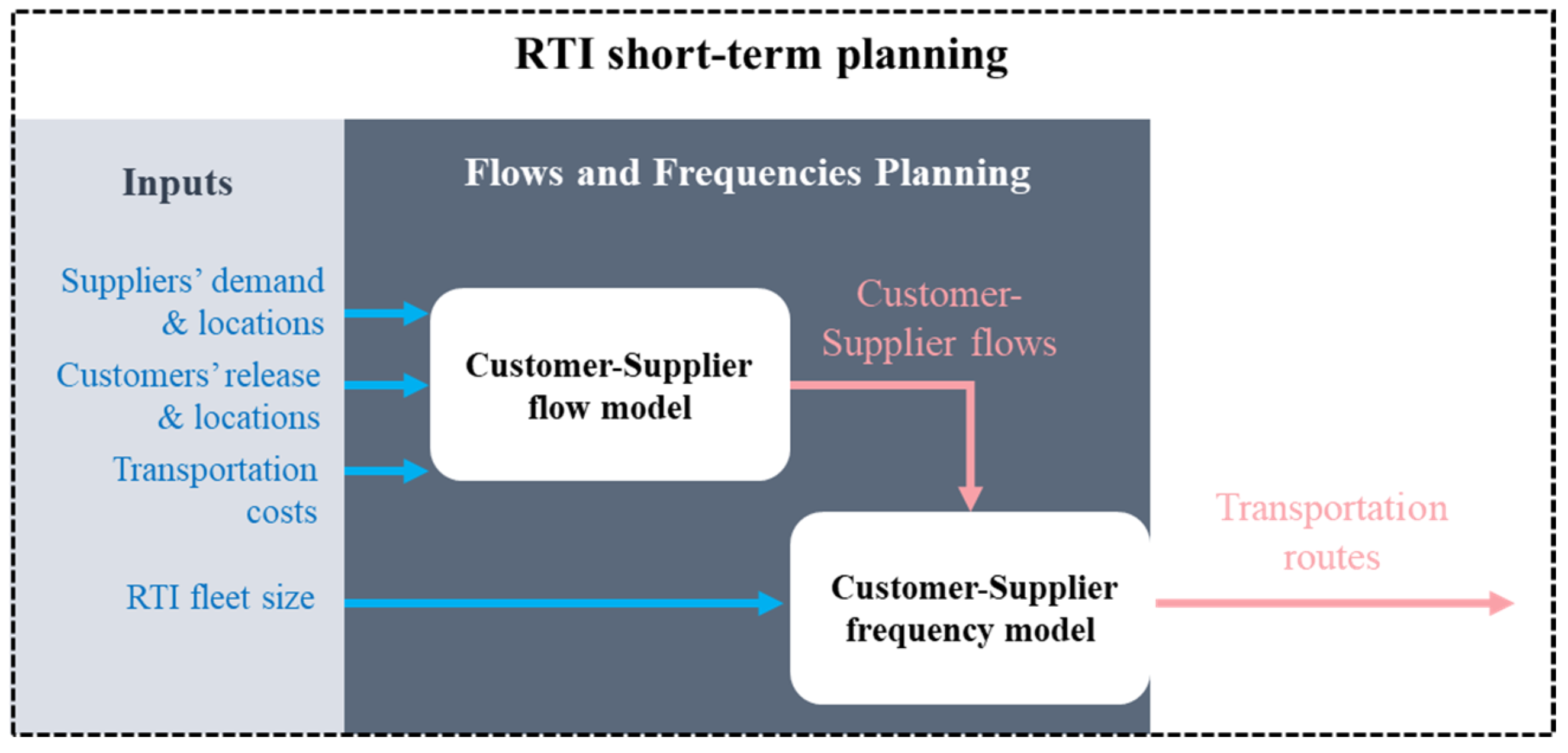
3.4. Model Formulation
3.4.1. Notations
- K: the set of suppliers.
- J: the set of customers.
- R: the set of RTI types.
- : the average internal transit time for an empty RTI at supplier , which includes the storage time from the arrival of the empty RTI and the processing time along the production line of the supplier until the empty RTI is loaded with parts.
- : the average transportation lead time for a loaded RTI between supplier to customer (forward flows).
- : the average internal transit time for a loaded RTI at the customer , which includes the storage time from the arrival of the loaded RTI and the processing time along the production line of the customer until the loaded RTI is emptied of parts.
- : the average transportation lead time for an empty RTI between supplier to customer (reverse flows).
- : the average periodic flow of a loaded RTI of type , delivered by supplier to customer (forward flows).
- : the average delivery batch for loaded RTIs delivered from the supplier to the customer for the RTI of type (forward flows). For example, could be 1000 loaded RTI units per week and could be 500 units, meaning that two deliveries are performed per week with a quantity of 500 units per delivery to satisfy the 1000 loaded RTI units.
- : the average periodic quantity of empty RTIs of type demanded by supplier .
- : the average periodic quantity of empty RTIs of type released by the customer .
- : the transportation cost charged for a truck returning empty RTIs from customer to supplier .
- : the maximum quantity of empty RTIs of type that can be transported in a truck. It should be noted that the capacity of trucks for loaded and empty RTIs can be different if the RTIs are collapsible (foldable). In our study, we have both cases: collapsible and non-collapsible RTIs. In the parameter , we take this aspect into account by computing the number of empty RTIs that can be transported in a truck.
- : the minimum return frequency per customer–supplier link (in number of trucks per period).
- : time bucket parameter (in number of periods) (minimum period in which we will have at least one delivery).
- : the fixed inventory requirement for loaded RTIs of type to operate the forward flows (independent of the short-term planning problem, because our models study only the reverse flows of empty RTIs sent by customers to suppliers).
- : the total quantity of RTIs of type available in the network including loaded and empty RTIs (RTI fleet size).
- : the available quantity of empty RTIs of type in the network for the reverse flows.
- : the safety inventory of RTIs of type which compensates for the effects of variability that may be encountered at the very-short-term level. This parameter is set empirically (in our case, we compute it as a fraction of the total RTI inventory requirement), but it will be possible to check whether it is sufficient or not depending on the results of very-short-term planning. Typically, too many shortages would mean that the safety inventory must be increased.
- : the incremental value used to increase the return frequency at each iteration of the heuristic in the Customer–Supplier Frequency model.
- : the overall RTI inventory requirement for RTI type , i.e., the quantity of RTIs required for each type of RTI in the network considered, including loaded and empty RTIs.
- : the variable inventory requirement for empty RTIs of type to operate the reverse flows (dependent on the short-term planning problem).
- : the average periodic quantity of empty RTIs of type returned from customer to supplier (during time bucket T). This variable corresponds to the flow of empty RTIs on customer–supplier link optimized in the Customer–Supplier Flow model.
- : the average periodic return frequency between customer to supplier , which equals the average number of trucks used for each customer (during time bucket T). This variable corresponds to the return frequency of empty RTIs on customer–supplier link optimized in the Customer–Supplier Frequency model.
- : the average delivery batch for empty RTIs between customer to supplier for the RTIs of type . This variable corresponds to the flow of empty RTIs divided by the return frequency on customer–supplier link .
3.4.2. RTI Inventory Requirement Formulation
3.4.3. Customer–Supplier Flow Model
Objective Function
Optimization Constraints
- The average total quantity of empty RTIs for each RTI type received by each supplier from all customers should be equal to its average demand:
- The average total quantity of empty RTIs for each RTI type returned by each customer to all suppliers should be equal to its average release:In the context studied, the return frequencies must respect a minimum return frequency per customer–supplier link. This constraint is related to the information systems that manage the transportation routes in the company studied. The frequency determined with the Customer–Supplier Flow and Frequency models on each customer–supplier link per period must be higher than the minimum return frequency set (e.g., a minimum return frequency of once a week means that at least one truck is scheduled per week on each customer–supplier link).
- The average frequency for each customer–supplier link is given by the average flow (i.e., quantity) over all types of RTIs divided by the maximum quantity that can be loaded in a truck. The return frequency during time bucket T can be seen as a round-up of the quantity transported during time bucket T divided by the truck capacity. Since the flow is calculated over the duration corresponding to the time bucket T, the return frequency will respect the minimum return frequency constraint because we consider only integer frequencies in the model.
- Finally, flow variables must be integer values. In addition, frequency values must also be integers so that we can translate them into a number of trucks to build the transportation routes subsequently.
3.4.4. Customer–Supplier Frequency Model
- The increase in frequency must increase transportation cost as little as possible.
- The increase in frequency must reduce the variable inventory requirement for the RTI type in shortage as significantly as possible.
4. Case Study
5. Conclusions
Author Contributions
Funding
Conflicts of Interest
Appendix A


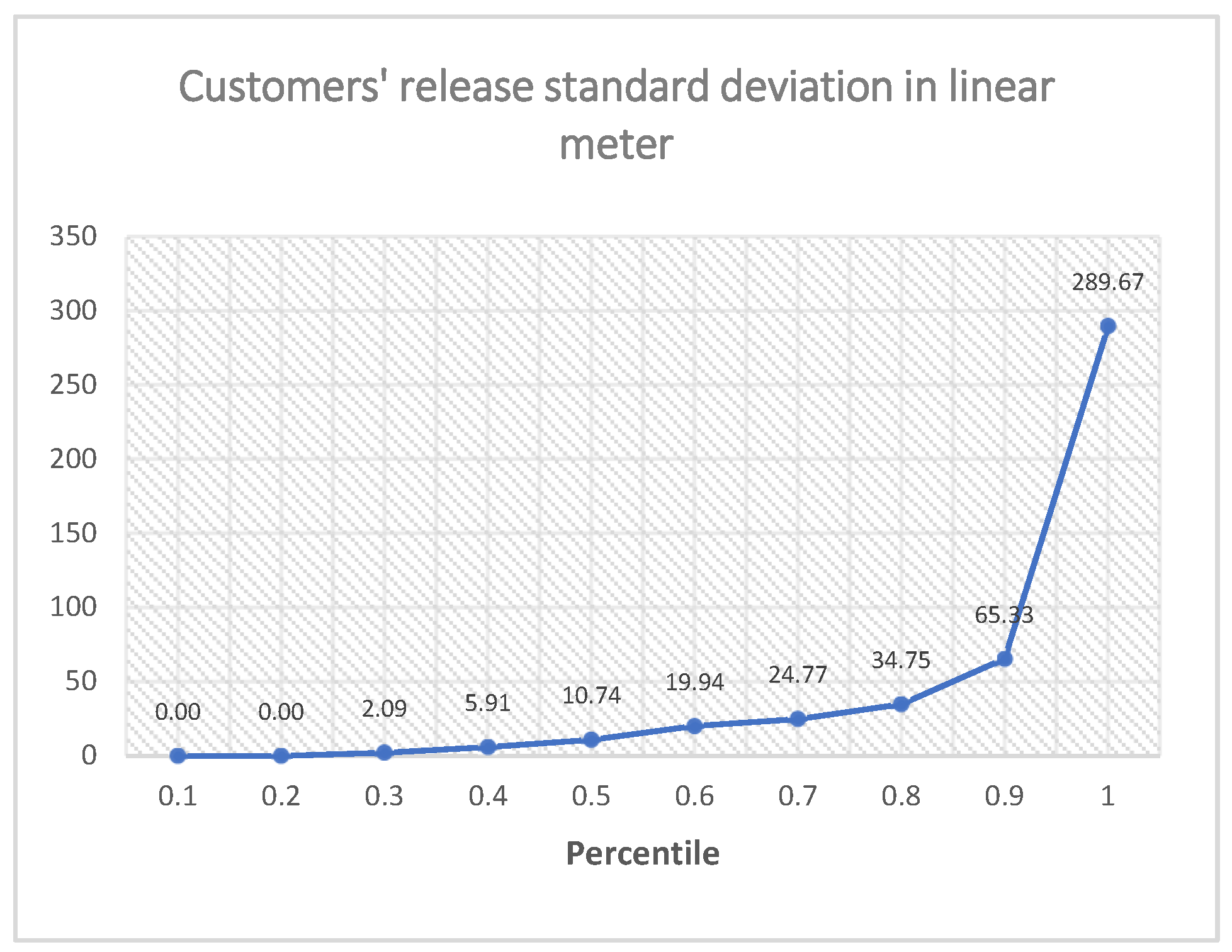
- The first step consists in optimizing the flows between the customers and the predefined suppliers by taking into account only pool RTIs (i.e., the demand of the suppliers and the release of the customers consider only pool RTIs). The output of this step is to obtain the pool RTI flows between customers and suppliers.
- The second step is to calculate the return frequency on each customer–supplier link. The return frequency must take into account the pool RTI flows defined in the previous step and the predefined dedicated RTI flows.
References
- Cars, Planes, Trains: Where do CO2 Emissions from Transport Come from? Our World in Data. 2020. Available online: https://ourworldindata.org/co2-emissions-from-transport (accessed on 9 November 2022).
- Lange, J.-C. Design and Management of Networks with Fixed Transportation Costs. Ph.D. Thesis, UCL-Université Catholique de Louvain, Ottignies-Louvain-la-Neuve, Belgium, 2010. [Google Scholar]
- Tancrez, J.-S.; Lange, J.-C.; Semal, P. A location-inventory model for large three-level supply chains. Transp. Res. Part E Logist. Transp. Rev. 2012, 48, 485–502. [Google Scholar] [CrossRef] [Green Version]
- Tornese, F.; Gnoni, M.G.; Thorn, B.K.; Carrano, A.L.; Pazour, J.A. Management and Logistics of Returnable Transport Items: A Review Analysis on the Pallet Supply Chain. Sustainability 2021, 13, 12747. [Google Scholar] [CrossRef]
- Kim, T.; Glock, C.H. On the use of RFID in the management of reusable containers in closed-loop supply chains under stochastic container return quantities. Transp. Res. Part E Logist. Transp. Rev. 2014, 64, 12–27. [Google Scholar] [CrossRef]
- Martínez-Sala, A.S.; Egea-López, E.; García-Sánchez, F.; García-Haro, J. Tracking of Returnable Packaging and Transport Units with active RFID in the grocery supply chain. Comput. Ind. 2009, 60, 161–171. [Google Scholar] [CrossRef] [Green Version]
- Accorsi, R.; Baruffaldi, G.; Manzini, R. A closed-loop packaging network design model to foster infinitely reusable and recyclable containers in food industry. Sustain. Prod. Consum. 2020, 24, 48–61. [Google Scholar] [CrossRef]
- Na, B.; Sim, M.K.; Lee, W.J. An Optimal Purchase Decision of Reusable Packaging in the Automotive Industry. Sustainability 2019, 11, 6579. [Google Scholar] [CrossRef] [Green Version]
- Cobb, B.R. Inventory control for returnable transport items in a closed-loop supply chain. Transp. Res. Part E Logist. Transp. Rev. 2016, 86, 53–68. [Google Scholar] [CrossRef]
- Fan, X.; Gong, Y.; Xu, X.; Zou, B. Optimal decisions in reducing loss rate of returnable transport items. J. Clean. Prod. 2019, 214, 1050–1060. [Google Scholar] [CrossRef]
- Achamrah, F.E.; Riane, F.; Sahin, E.; Limbourg, S. An Artificial-Immune-System-Based Algorithm Enhanced with Deep Reinforcement Learning for Solving Returnable Transport Item Problems. Sustainability 2022, 14, 5805. [Google Scholar] [CrossRef]
- Zhang, Y.; Chu, F.; Che, A. Closed-loop Inventory Routing Problem for Perishable Food with Multi-type Returnable Transport Items. IFAC-Pap. 2022, 55, 2828–2833. [Google Scholar] [CrossRef]
- Iassinovskaia, G.; Limbourg, S.; Riane, F. The inventory-routing problem of returnable transport items with time windows and simultaneous pickup and delivery in closed-loop supply chains. Int. J. Prod. Econ. 2017, 183, 570–582. [Google Scholar] [CrossRef] [Green Version]
- Soysal, M. Closed-loop Inventory Routing Problem for returnable transport items. Transp. Res. Part D Transp. Environ. 2016, 48, 31–45. [Google Scholar] [CrossRef]
- Tanksale, A.N.; Das, D.; Verma, P.; Tiwari, M.K. Unpacking the role of primary packaging material in designing green supply chains: An integrated approach. Int. J. Prod. Econ. 2021, 236, 108133. [Google Scholar] [CrossRef]
- Accorsi, R.; Baruffaldi, G.; Manzini, R.; Pini, C. Environmental Impacts of Reusable Transport Items: A Case Study of Pallet Pooling in a Retailer Supply Chain. Sustainability 2019, 11, 3147. [Google Scholar] [CrossRef] [Green Version]
- Bottani, E.; Casella, G. Minimization of the Environmental Emissions of Closed-Loop Supply Chains: A Case Study of Returnable Transport Assets Management. Sustainability 2018, 10, 329. [Google Scholar] [CrossRef]
- Lakhmi, N. Returnable Transport Items Flow Optimization with an Application to the Automotive Supply Chain. Ph.D. Thesis, Université Paris-Saclay, Gif-sur-Yvette, France, 2021. Available online: https://www.theses.fr/2021UPAST131 (accessed on 7 November 2022).
- Little, J.D.C.; Graves, S.C. Little’s Law. In Building Intuition: Insights from Basic Operations Management Models and Principles; Chhajed, D., Lowe, T.J., Eds.; International Series in Operations Research & Management Science; Springer: Boston, MA, USA, 2008; pp. 81–100. ISBN 978-0-387-73699-0. [Google Scholar]
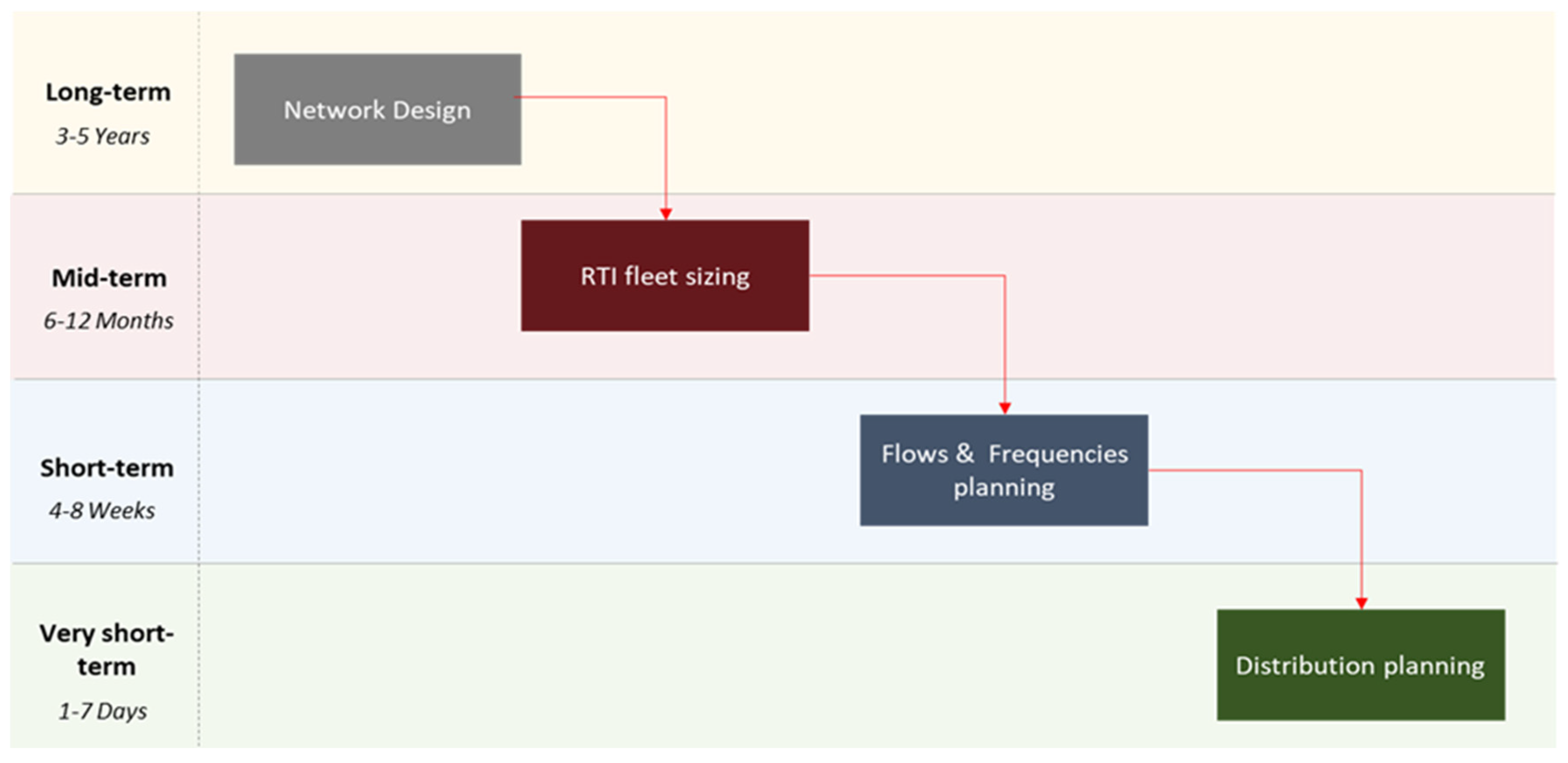
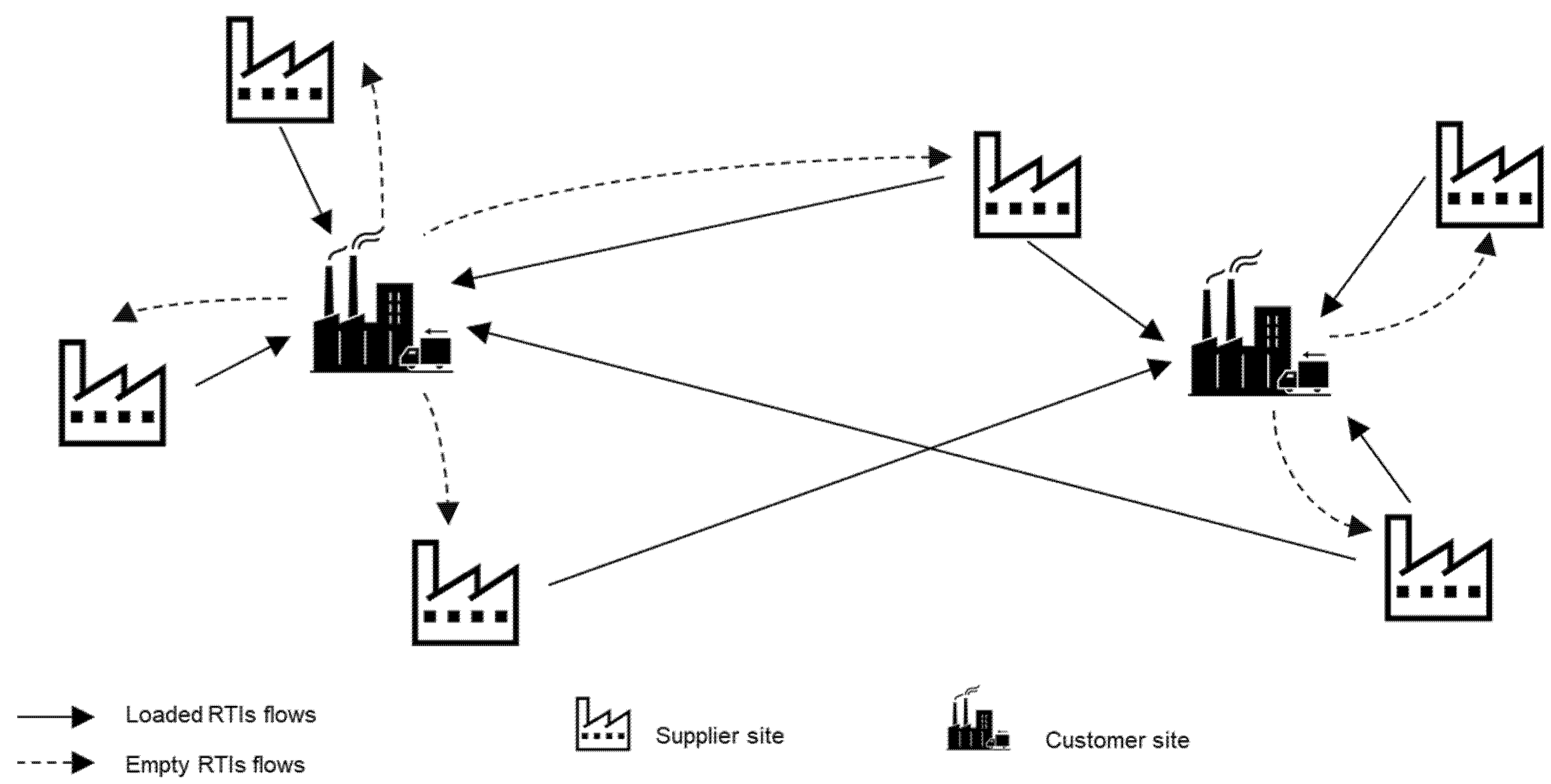
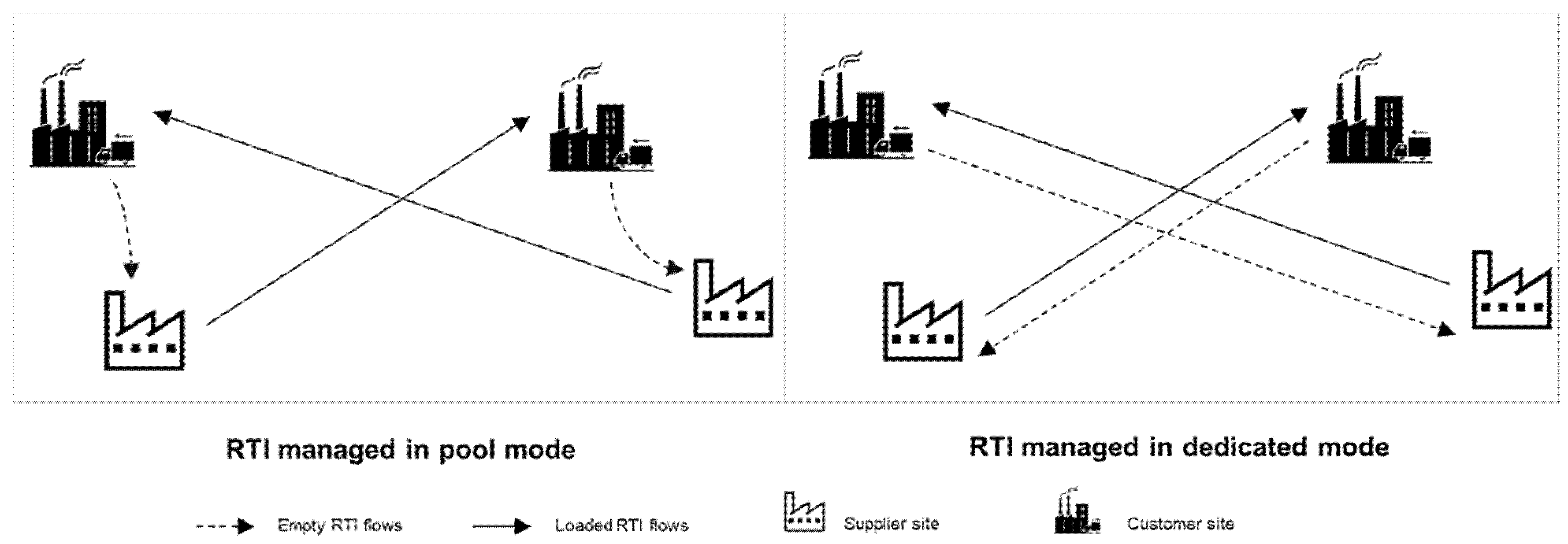
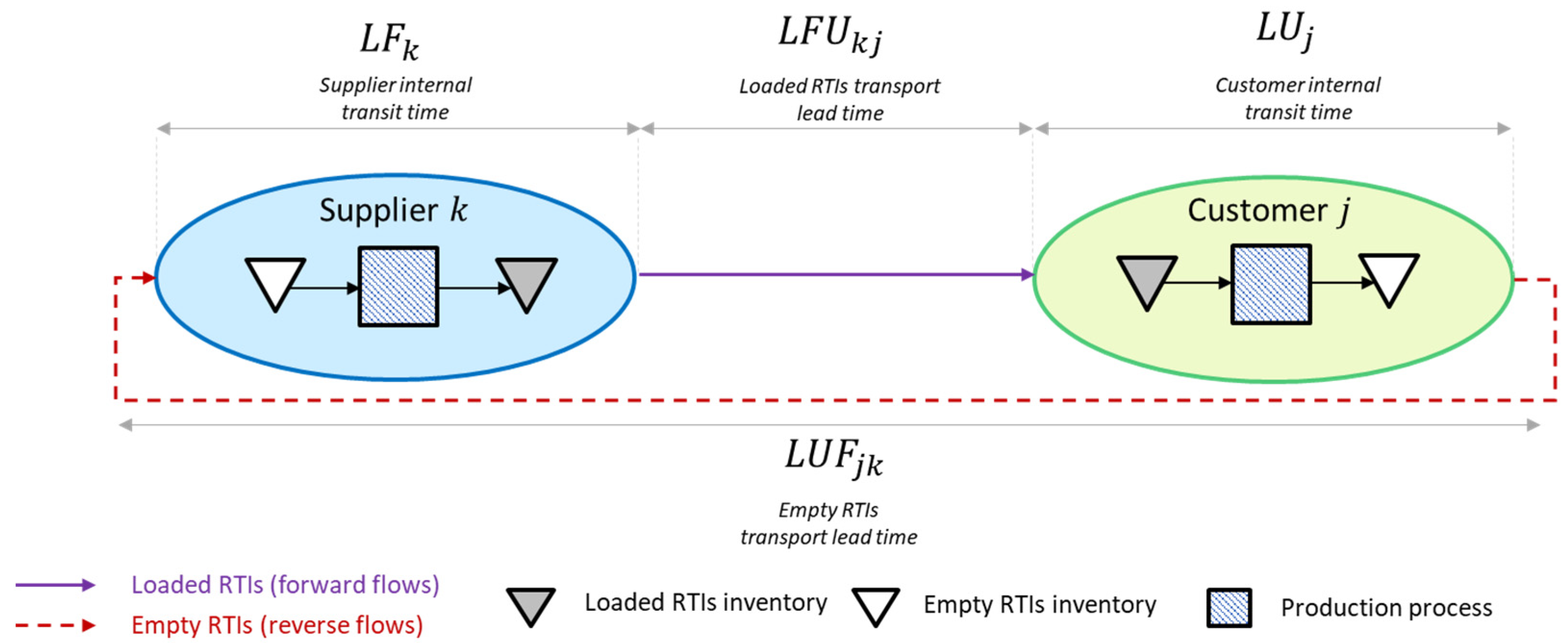

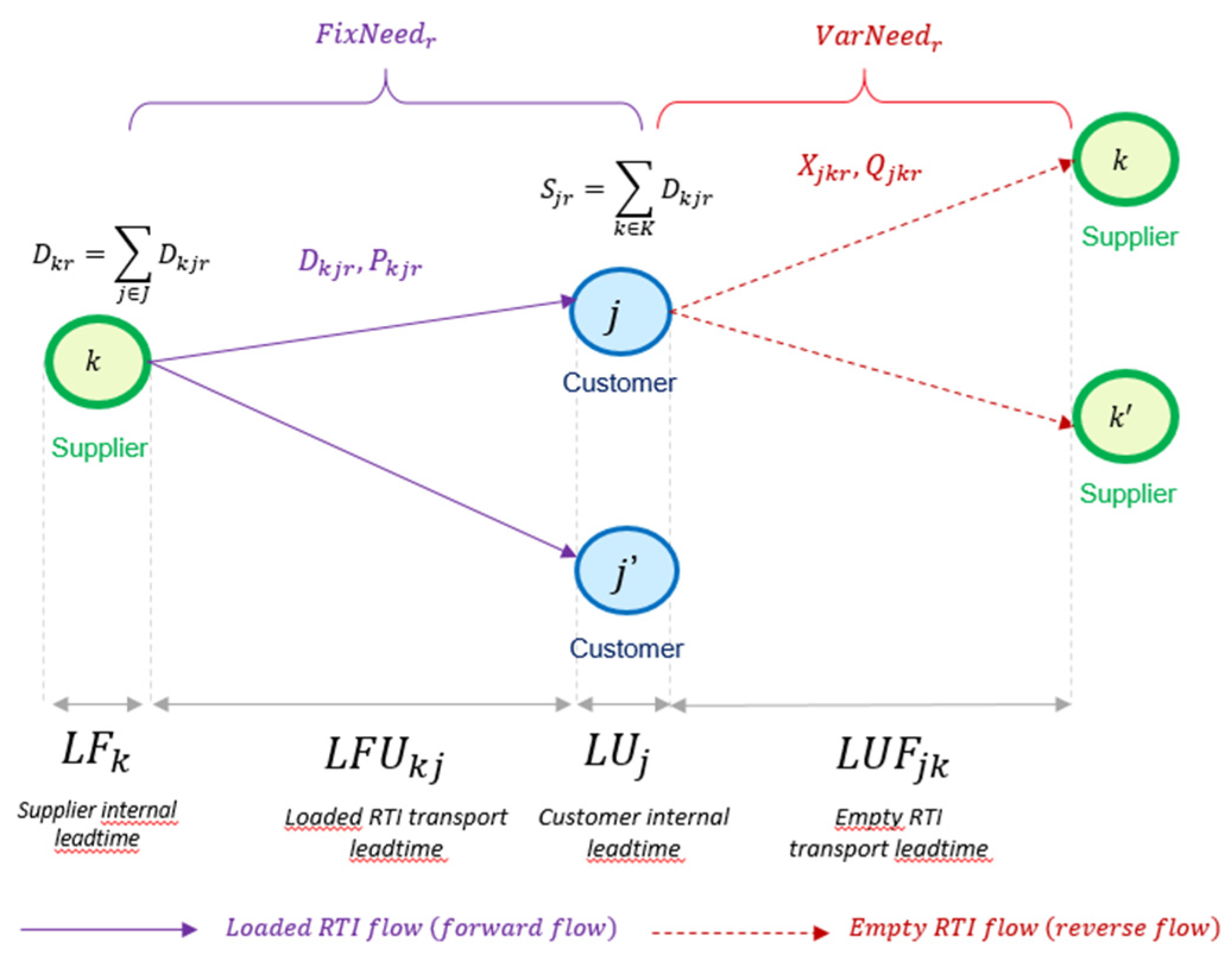
| Research Paper | Objective | Perspective | Methodology |
|---|---|---|---|
| [2] | RTI flows and frequencies planning | Supply chain, single-RTI type | Optimization model |
| [3] | RTI flow design and management | Supply chain, single-RTI type | Review |
| [5] | Method for managing and evaluating the use of RFID in the tracking of RTIs | Single-supplier, single-customer, single-RTI type | Optimization model |
| [6] | Design and architecture of information systems for the pooling of RTIs | Supply chain, single-RTI type | Design approach |
| [7] | Design of RTI pooling network | Supply chain, single-RTI type | Optimization model |
| [7] | RTI fleet sizing | Single-supplier, single-customer, single-RTI type | Simulation model |
| [9] | RTI inventory management under uncertain returns | Single-supplier, single-customer, single-RTI type | Optimization model |
| [10] | RTI inventory management with RTI loss | Single-supplier, single-customer, single-RTI type | Optimization model |
| [10] | RTI inventory routing | Supply chain, multi-RTI type | Optimization model |
| [12] | RTI inventory routing | Single-supplier, multi-customer, multi-RTI type | Optimization model |
| [13] | RTI inventory routing with time windows | Single-supplier, multi-customer, single-RTI type | Optimization model |
| [14] | RTI inventory routing with uncertainty | Single-supplier, multi-customer, single-RTI type | Optimization model |
| [15] | RTI network design with green objectives | Supply chain, multi-RTI type | Optimization model |
| [16] | RTI flow design and management | Supply chain, single-RTI type | Comparative analysis |
| Current Transportation Routes | Transportation Routes Obtained by Short-Term Planning Models | Gap % | |
|---|---|---|---|
| Number of trucks used | 1046 | 840 | −20% |
| Average distance per truck | 314 Km | 220 Km | −30% |
| Configuration | Scenario 0 | Scenario 1 | Gap % |
|---|---|---|---|
| Transportation cost obtained with Customer–Supplier Flow model | 4299 k€ | 3941 k€ | 8% |
| Configuration | Scenario 0 | Scenario 1 | Gap % |
|---|---|---|---|
| RTI variable inventory requirement | 920,803 | 835,333 | 9% |
| Configuration | Scenario 0 | Scenario 1 | Gap% |
|---|---|---|---|
| Transportation cost obtained with Customer–Supplier Frequency model | 4338 k€ | 3944 k€ | 9% |
Publisher’s Note: MDPI stays neutral with regard to jurisdictional claims in published maps and institutional affiliations. |
© 2022 by the authors. Licensee MDPI, Basel, Switzerland. This article is an open access article distributed under the terms and conditions of the Creative Commons Attribution (CC BY) license (https://creativecommons.org/licenses/by/4.0/).
Share and Cite
Lakhmi, N.; Sahin, E.; Dallery, Y. Modelling the Returnable Transport Items (RTI) Short-Term Planning Problem. Sustainability 2022, 14, 16796. https://doi.org/10.3390/su142416796
Lakhmi N, Sahin E, Dallery Y. Modelling the Returnable Transport Items (RTI) Short-Term Planning Problem. Sustainability. 2022; 14(24):16796. https://doi.org/10.3390/su142416796
Chicago/Turabian StyleLakhmi, Najoua, Evren Sahin, and Yves Dallery. 2022. "Modelling the Returnable Transport Items (RTI) Short-Term Planning Problem" Sustainability 14, no. 24: 16796. https://doi.org/10.3390/su142416796





